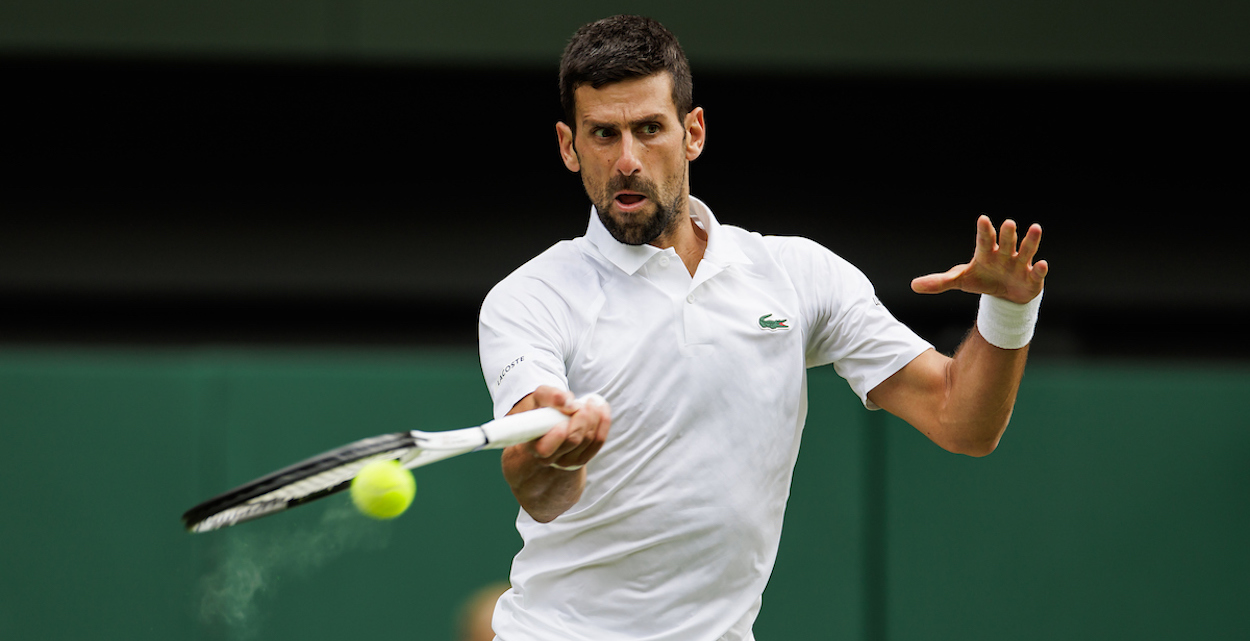
Tennis strategy: Why your second shot in a rally can be just as important as your serve
Top tennis strategy expert and creator of Brain Game Tennis Craig O’Shannessy explains how the statistics show the value of a forehand as the server’s follow-up shot.
Let’s talk Serve +1. The best match in the men’s draw at the 2022 US Open was Carlos Alcaraz’s five-set thriller against Jannik Sinner in the quarter-finals. The Spaniard won 6-3 6-7(7) 6-7(0) 7-5 6-3 in five hours and 15 minutes and saved a match point along the way.
Let’s analyse Serve +1 performance from this blockbuster to understand this hidden strategy component in service games. Specifically, Serve +1 is the first shot after the serve, which will typically be a forehand or backhand from the back of the court.
Does it matter if it’s a forehand or a backhand? You are about to uncover an intelligent layer of our sport that will help you hold serve more often. Alcaraz and Sinner both hunted as many forehands as they could get as their Serve +1 shot.
Serve + 1 forehand total
- Alcaraz: 66 per cent (84/127)
- Sinner: 66 per cent (89/135)
Both players hit right at two out of three Serve +1 shots as a forehand. In our sport the forehand is the sword and the backhand is the shield. Forehands contribute around 70 per cent of winners from the back of the court, while backhands are at 30 per cent. The maths are simple. The more forehands you hit, the better. How did they do with this tactic? Alcaraz definitely took the honours.
Serve +1 forehand win percentage
- Alcaraz: won 61 per cent (51/84)
- Sinner: won 54 per cent (48/89)
The first goal here is always to win north of 50 per cent. Both players achieved that, with Alcaraz performing better than Sinner by seven percentage points. It was fairly even with Serve +1 forehands, but not even when the point started with a Serve +1 backhand.
Serve +1 backhand win percentage
- Alcaraz: won 49 per cent (21/43)
- Sinner: won 28 per cent (13/46)
There is a significant difference in performance between the two players when the point kicked off with a serve and then a backhand. Alcaraz won a respectable 49 per cent of these points, while Sinner languished well behind at 28 per cent. This highlights an area of the Italian’s game that certainly underperformed.
Alcaraz hit 15 Serve +1 winners (12 forehand and three backhand), while Sinner could manage only nine (eight forehand and one backhand). That meant that Alcaraz could apply a lot more pressure early in the point in his service games. Alcaraz committed 20 Serve +1 errors (13 forehand and seven backhand), while Sinner was slightly higher at 21 (11 forehand and 10 backhand).
Serve +1 performance was remarkably different when the point started with a second serve for each player. Alcaraz won 63 per cent when the point started with a Serve +1 forehand and 55 per cent beginning with a Serve +1 backhand. These substantial numbers powered Alcaraz to win 59 per cent of his second-serve points.
Sinner won only 43 per cent of his second serve points and his Serve +1 performance clearly suffered in this area. Sinner won 50 per cent (15/30) of second serve points starting with a serve and a forehand, but only 24 per cent (8/33) beginning with a Serve +1 backhand.
We used to think that the serve was the “king maker” at the start of the point. It’s much better to combine the serve and the first shot after the serve into one unit to understand better how to hold serve. For both Alcaraz and Sinner, the more forehands you hit, the better.
How to tweak your tennis strategy
Now, let’s shine the spotlight on your own game and your own tennis strategy. We know what matters at the pro level. Do the same rules wash over to the amateur level as well?
Let’s create a fun learning scenario from an upcoming match. You bounce the ball and look over the net at your opponent. You are serving in the deuce court, and right now, serving out wide seems like a good idea. You toss the ball high, hitting the serve well and slicing it off the court. Your opponent reaches wide and hits an intelligent, defensive forehand return deep down the middle of the court.
What next? Seriously: what is the next step in your master plan to win this point? Specifically, what is the plan with your Serve +1 groundstroke? Are you looking for a forehand or settling for whatever the returner gives you? Is the primary pattern to go to the open court or to play behind? Have you got a rigid plan, or do you have options?
Think about your recent matches. Do you ever have a Serve +1 plan? You are about to. You DO have a plan for the serve. You always pick a direction out wide, at the body, or down the T. You control if the returner hits a forehand or backhand return. So what about your next shot? Do you have a plan for your Serve +1 shot? You absolutely need to!
At the 2023 Australian Open, 70 per cent of all serves in the men’s draw came back into play. Here’s the breakdown.
2023 AUSTRALIAN OPEN: MEN
| Unreturned | Total | Per cent unreturned | Per cent returned | |
| 1st serves | 6,395 | 18,879 | 37% | 63% |
| 2nd serves | 1,648 | 9,594 | 17% | 83% |
| Combined | 8,583 | 28,473 | 30% | 70% |
Almost two out of three first serves come back into play and more than four out of five second serves developed into a rally. Here’s the bottom line. It’s not good enough only to have a plan for your serve.
You need to be thinking about your Serve +1 shot as well. You need a plan for it too. In fact, you need a couple of plans based on the strength of the return that comes back.
In the women’s draw, more than three out of four serves came back into play this year Down Under.
2023 AUSTRALIAN OPEN: WOMEN
| Unreturned | Total | Per cent unreturned | Per cent returned | |
| 1st serves | 2,957 | 10,874 | 27% | 73% |
| 2nd serves | 934 | 5,395 | 17% | 83% |
| Combined | 3,891 | 16,269 | 24% | 76% |
As you can see, the vast majority of serves come back into play. Therefore, your Serve +1 shot needs to have some structure and planning. You need a primary pattern of play based on what you want to happen most of the time.
Then, you need a secondary pattern of play to cover for the unexpected. For example, if the return is weak and short down the middle where you want it, then the primary pattern is to immediately attack the opponent’s running backhand in the vacant ad court.
But what if the returner hits a great cross-court return? Then it’s time to play defence and direct the ball back cross-court behind the returner. Having a plan when serving is obvious. It should also be the same for your Serve +1 shot. The more you hunt Serve +1 forehands, the better.

Craig runs a tennis strategy website at braingametennis.com.
He is the strategy analyst for the ATP World Tour, Wimbledon, The New York Times, Tennis Canada and the players Matteo Berrettini, Jan-Lennard Struff and Alexei Popyrin
![]() Join >> Receive $700/£600 of tennis gear from the Tennishead CLUB
Join >> Receive $700/£600 of tennis gear from the Tennishead CLUB
![]() Social >> Facebook, Twitter & YouTube
Social >> Facebook, Twitter & YouTube
![]() Read >> World’s best tennis magazine
Read >> World’s best tennis magazine
![]() Shop >> Lowest price tennis gear from our trusted partner
Shop >> Lowest price tennis gear from our trusted partner


